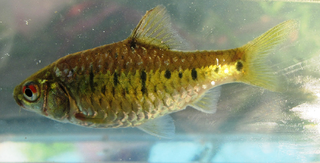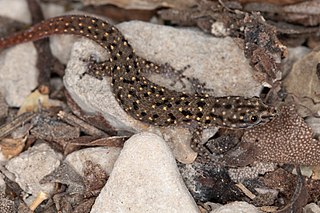
Barbodes semifasciolatus, the Chinese barb, is a species of cyprinid fish native to the Red River basin in southeast Asia where they occur in fresh waters at depths of 5 metres (16 ft) or less. The captive variant popularly known as the gold barb or Schuberti barb is an extremely popular aquarium fish.

The golden barb or golden dwarf barb is a species of cyprinid fish native to inland waters in Asia, and is found in Pakistan, India, and Bangladesh. It has also been introduced to waters in Colombia. It natively inhabits rivers, and standing water with a silty bottom. They live in a tropical climate in water with a 6.0 - 6.5 pH, a water hardness of 8 - 15 dGH, and a temperature range of 68 - 77 °F. It feeds on benthic and planktonic crustaceans, and insects. This species can grow in length up to 5.1 centimetres (2.0 in) TL. It can also be found in the aquarium trade.

Stefania is a genus of frogs in the family Hemiphractidae. They are native to the highlands of the Guiana Shield in southern Venezuela, Guyana, and adjacent far northern Brazil. Most are restricted to the tepui highlands, but S. evansi also occurs in lowlands. On most mountains there are only 1–2 species from this genus, but five are known from Mount Ayanganna and the neighbouring Mount Wokomung has six species. They are usually found near streams at low levels on branches/leaves or on the ground among vegetation/rocks.
Stefania ackawaio is a species of frog in the family Hemiphractidae. It is endemic to Guyana. Its natural habitat is subtropical or tropical moist montane forests.

Stefania breweri, also known as Brewer's carrying frog, is a species of frog in the family Hemiphractidae. It is endemic to Cerro Autana, Venezuela, and only known from a single specimen (holotype). It was named for Venezuelan explorer Charles Brewer-Carías.
Stefania coxi is a species of frog in the family Hemiphractidae. It is endemic to Guyana and has been found on Mount Ayanganna and Mount Wokomung. Its natural habitat is subtropical or tropical moist montane forests at higher elevations.
Stefania ginesi is a species of frog in the family Hemiphractidae. It is endemic to the Chimantá Massif, Venezuela. Its natural habitats are humid rocky habitats on tepuis. While its range is restricted, it is a common species within its range. It can be found in crevices, caves, on open rock surfaces and adjacent peat bogs, in streams and rivers. Its range overlaps with the Canaima National Park.
Stefania goini is a species of frog in the family Hemiphractidae. It is endemic to Amazonas, Venezuela, and known from Cerro Duida and the nearby Cerro Huachamacari. Its natural habitats are streams on the tops of tepuis. It usually occurs on rocks.
Stefania marahuaquensis is a species of frog in the family Hemiphractidae. It is endemic to Venezuela and known from Cerro Duida and Cerro Marahuaca, both in Amazonas State. Its occurs on rocks along the forested margins of small streams at elevations of 340–1,200 m (1,120–3,940 ft) asl. The range is within the Duida–Marahuaca National Park, and no major threats to this species have been identified.
Stefania oculosa is a species of frog in the family Hemiphractidae. It is endemic to the Bolívar state of southern Venezuela and only known from Cerro Jaua, a tepui; it possibly occurs more widely. It was found on rocks in a fast-flowing cascading stream where it co-occurred with Stefania percristata. The known range is within the Jaua-Sarisariñama National Park, and the species is not facing known threats.
Stefania percristata is a species of frog in the family Hemiphractidae. It is endemic to Venezuela and only known from its type locality, Cerro Jaua in Bolívar State. It occurs along streams at the top of the tepui. It is a nocturnal species found on branches of vegetation 0.3–1 m above the ground.
Stefania riae is a species of frog in the family Hemiphractidae. This species is only known from Cerro Sarisariñama, a tepui in the Bolívar State, Venezuela.
Stefania riveroi is a species of frog in the family Hemiphractidae. It is only known from Yuruaní tepui, a tepui on the border of Venezuela and Guyana. Its habitats are subtropical or tropical moist montane forests, subtropical or tropical high-altitude shrubland, rivers and rocky areas.
Stefania roraimae is a species of frog in the family Hemiphractidae. It is endemic to Guyana. Its type locality is Mount Roraima; it is also known from Mount Ayanganna and Mount Wokomung. It presumably occurs in the adjacent Venezuela and Brazil too.
Stefania satelles is a species of frog in the family Hemiphractidae. It is endemic to Venezuela.
Stefania tamacuarina is a species of frog in the family Hemiphractidae. It is found in the Sierra Tapirapecó in the Amazonas state of Venezuela as well as in the adjacent Amazonas state of Brazil. The specific name tamacuarina refers to the type locality, a spur ridge north of Pico Tamacuari.

Josefa Celsa Señaris is a Venezuelan herpetologist. She has published information about frogs and she has identified new genera and species. Señaris is the director of the La Salle Foundation's Natural History Museum in Caracas.

Jaua-Sarisariñama National Park was located in the Guayana Highlands, within Bolívar State of southeastern Venezuela. It was established in 1978. It has been subsumed within Caura National Park, which was established in 2017.
Cerro Jaua is a tepui in Bolivar State, Venezuela. The mountain has a height of 2395 meters, It was included in Jaua-Sarisariñama National Park which has been subsumed within Caura National Park.

The Neiba agave sphaero, also known commonly as the Neiba agave geckolet and Schubert's least gecko, is a species of lizard in the family Sphaerodactylidae. The species is endemic to the Dominican Republic.







